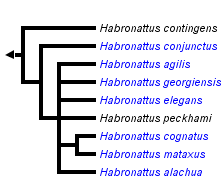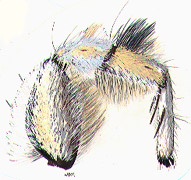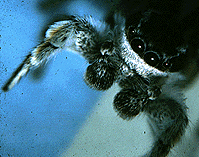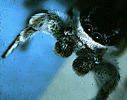Habronattus agilis group
Wayne Maddison


This tree diagram shows the relationships between several groups of organisms.
The root of the current tree connects the organisms featured in this tree to their containing group and the rest of the Tree of Life. The basal branching point in the tree represents the ancestor of the other groups in the tree. This ancestor diversified over time into several descendent subgroups, which are represented as internal nodes and terminal taxa to the right.

You can click on the root to travel down the Tree of Life all the way to the root of all Life, and you can click on the names of descendent subgroups to travel up the Tree of Life all the way to individual species.
For more information on ToL tree formatting, please see Interpreting the Tree or Classification. To learn more about phylogenetic trees, please visit our Phylogenetic Biology pages.
close boxIntroduction
The agilis group includes a number of very similar species sharing a large carapace-abdomen stridulatory apparatus (Maddison and Strattion, 1988) and vertically fringed first legs in males. They tend toward sandy habitats, and can dig into sand to build retreats beneath the surface.Characteristics
The most striking characteristic of the agilis group is the stridulatory apparatus between the carapace and abdomen of males:

 The faces of males are white to red or black and have tufts of hairs on the sides that blend with the fringe of hairs of the first femur:
The faces of males are white to red or black and have tufts of hairs on the sides that blend with the fringe of hairs of the first femur:
 .
.
References
Griswold, C. E. 1987. A revision of the jumping spider genus Habronattus F.O.P.-Cambridge (Araneae; Salticidae), with phenetic and cladistic analyses. University of California Publications, Entomology 107: 1-344.
Maddison, W. P. and G. E. Stratton. 1988. Sound production and associated morphology in male jumping spiders of the Habronattus agilis species group (Araneae: Salticidae). J. Arachnology 16: 199-211.
Title Illustrations

| Copyright |
© 1994-1995 Wayne Maddison

|
|---|
About This Page
Wayne Maddison

University of British Columbia, Vancouver, British Columbia, Canada
Correspondence regarding this page should be directed to Wayne Maddison at
Page copyright © 1995 Wayne Maddison
All Rights Reserved.
Citing this page:
Maddison, Wayne. 1995. Habronattus agilis group. Version 01 January 1995 (under construction). http://tolweb.org/Habronattus_agilis_group/4047/1995.01.01 in The Tree of Life Web Project, http://tolweb.org/







 Go to quick links
Go to quick search
Go to navigation for this section of the ToL site
Go to detailed links for the ToL site
Go to quick links
Go to quick search
Go to navigation for this section of the ToL site
Go to detailed links for the ToL site